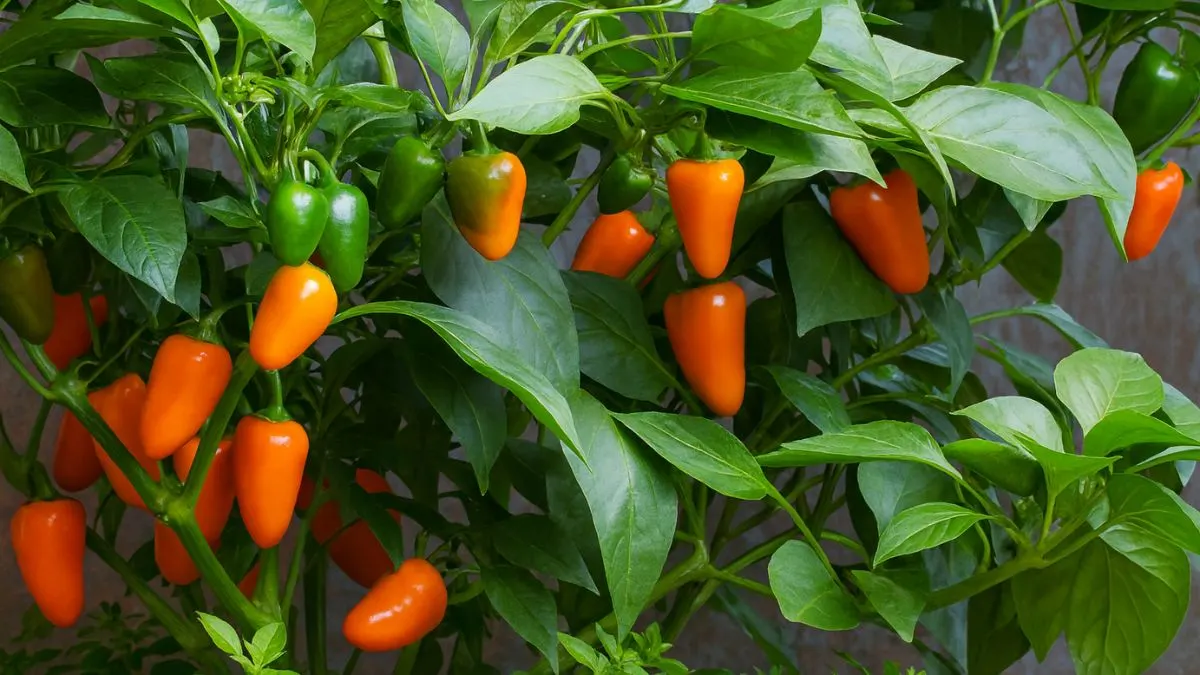Peppers are one of the most rewarding crops to grow at home. From spicy chili peppers to sweet bell peppers, they add flavor, color, and nutrition to your kitchen. The good news? With the right care, they can thrive in both backyard gardens and container setups worldwide, including Canada, the USA, and India.
In this guide, I’ll walk you through everything you need to know about growing pepper plants—right from planting and soil preparation to watering and harvesting. I’ll also share practical tips and personal experiences that will help you grow healthy, productive pepper plants at home.
Why Grow Pepper Plants?

- Peppers are versatile—great for stir-fries, salads, sauces, and pickles.
- Available in countless varieties, from mild to extremely hot.
- Easy to grow in sunny gardens, raised beds, or containers.
- High in vitamins A and C, along with antioxidants.
- Fun and satisfying for gardeners of all skill levels.
When I grew my first pepper plant on a sunny balcony, I was amazed at how quickly it adapted. Within weeks, I had a lush green plant producing shiny fruits that tasted far better than anything from the market.
Sunlight Needs
Peppers love the sun. To thrive, always provide 6-8 hours of direct sunlight daily. Without enough light, plants grow leggy and fruit production suffers.
- Outdoor gardens: Select a sunny spot that gets all-day light.
- Indoor setups: Find a good and warm sunny windowsill to place your containers.
- In Canada and the USA: Use long summer days to your advantage.
- In India: Grow during cooler months to avoid extreme summer heat that may stress the plants.
Also Read: Morel Mushrooms: The Gourmet Treasure You Can Grow in Your Backyard
Soil Requirements
Healthy soil is the foundation of healthy peppers. Peppers prefer a sunny location, long growing season, and fertile, well-drained soil.
- Always use well-draining soil enriched with organic matter, and water regularly to maintain consistent moisture.
- Avoid clay-heavy soil that retains water.
- pH should range between 6.0 and 7.0.
- Compost or well-rotted manure helps boost fertility.
In my own trials, peppers grown in sandy-loam soil mixed with compost gave larger, tastier fruits compared to plants grown in plain garden soil.
Planting Pepper Plants
- Depth: Peppers like to be pretty deep in the soil. Plant them slightly deeper than their original nursery pot level to encourage stronger roots.
- Spacing: Plant them 18 to 24 inches apart in a sunny, well-drained spot. This allows proper airflow and reduces disease risk.
- Timing: Sow seeds indoors 6–8 weeks before the last frost (Canada/USA) or directly in garden beds in warm regions like India.
- Transplanting: Move seedlings outdoors only when the soil is warm enough, as peppers are sensitive to cold.
Watering and Moisture
Consistent watering is key.
- Keep the soil evenly moist but never waterlogged.
- Water deeply 2–3 times per week rather than shallow daily watering.
- Mulching helps retain soil moisture and reduce temperature stress.
- Avoid overhead watering to reduce fungal risks; water at the base of the plant instead.
From my experience, peppers that received deep soakings every few days produced healthier, juicier fruits compared to those watered lightly every day.
Also Read: The Incredible Effects of Aloe Vera on Your Body
Fertilizing and Maintenance
- Use balanced fertilizers with equal parts nitrogen, phosphorus, and potassium.
- Too much nitrogen encourages leafy growth but reduces fruiting.
- Prune lower leaves to improve airflow and reduce pest issues.
- Support tall plants with stakes or cages to prevent them from toppling under heavy fruit loads.
Key Requirements for Growing Peppers
Requirement |
Details |
Sunlight |
Provide 6-8 hours of direct sunlight daily |
Soil |
Use well-draining soil enriched with organic matter, and water regularly to maintain consistent moisture |
Depth |
Peppers like to be pretty deep in the soil |
Spacing |
Plant them 18 to 24 inches apart in a sunny, well-drained spot |
Indoor Growing |
Find a good and warm sunny windowsill |
Climate |
Peppers prefer a sunny location, long growing season, and fertile, well-drained soil |
Common Challenges
- Temperature Stress: Peppers dislike extreme cold or excessive heat. Growth slows if temperatures fall below 15°C or rise above 35°C.
- Pests: Aphids, whiteflies, and spider mites may attack. Regular checks and neem oil sprays work well.
- Diseases: Overwatering can lead to root rot and fungal issues. Ensure proper drainage.
- Blossom End Rot: Caused by calcium deficiency or irregular watering. Mulching and consistent moisture help.
Also Read: How to Grow Pumpkins for a Big, Festive Fall Harvest
Harvesting Pepper Plants
- Most peppers are ready to harvest within 60–90 days of planting.
- Harvest when fruits are firm and reach desired size and color.
- Cutting fruits with scissors instead of pulling prevents damage to the plant.
- Regular harvesting encourages the plant to produce more peppers.
I’ve found that peppers harvested at different ripening stages offer unique flavors—green peppers are tangy, while red ones are sweeter and richer.
Personal Experience
When I first tried growing peppers, I planted them too close together, and the airflow was poor. This led to fungal issues and small fruit production. Later, when I replanted them with proper spacing—plant them 18 to 24 inches apart in a sunny, well-drained spot—the plants grew stronger and healthier. Another lesson was the importance of sunlight. Placing one container near a window where I could find a good and warm sunny windowsill dramatically improved growth.
Growing peppers is a rewarding experience for gardeners of all skill levels. With just a little care, you’ll enjoy a steady supply of colorful, flavorful peppers in your kitchen.






